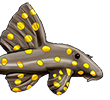Huang, R-R, J-M Chen, R-Y Zhang & W-T Chen, 2025. Phylogeography and demography of Pterocryptis cochinchinensis (Siluriformes: Siluridae) in Southern China. Global Ecology and Conservation e03728.
Abstract
The South China region, with its complex river system and mountains, served as a key Pleistocene refugium. We investigated the impact of historical climate fluctuations and geographical isolation on the genetic diversity of freshwater species in South China using Pterocryptis cochinchinensis as an exemplar. Two mitochondrial and two nuclear gene markers from 331 individuals across 14 populations were employed. Phylogenetic trees based on mtDNA loci confirmed three distinct lineages, whereas phylogenetic trees using 2 nuclear DNA loci did not obtain the signal of lineage division. Genetic diversity and differentiation indicated that P. cochinchinensis possesses significant genetic diversity, with variation among populations being the primary source of the total variation. SAMOVA supported two groups: one group comprising the Dongjiang and Beijiang River basins, and the other group including the basins of other rivers. The divergence time estimated between the two groups was 4.62 million years ago, which could be linked to the swift uplift of the Tibetan Plateau. Star-like network, EBSP analysis, and neutrality tests indicated the populations remained stable over a long period. Furthermore, the Wuyi Mountains and Nanling Mountains appear to serve as refuges for P. cochinchinensis populations. Geographic features such as the Qiongzhou Strait and Yinggeling Mountains may obstruct the expansion of P. cochinchinensis. These findings deepen our understanding of P. cochinchinensis' evolution and population structure, aiding conservation efforts.
Pterocryptis phylogeography
- Silurus
- Posts: 12484
- Joined: 31 Dec 2002, 11:35
- I've donated: $12.00!
- My articles: 55
- My images: 903
- My catfish: 1
- My cats species list: 90 (i:1, k:0)
- Spotted: 433
- Location 1: Singapore
- Location 2: Moderator Emeritus





